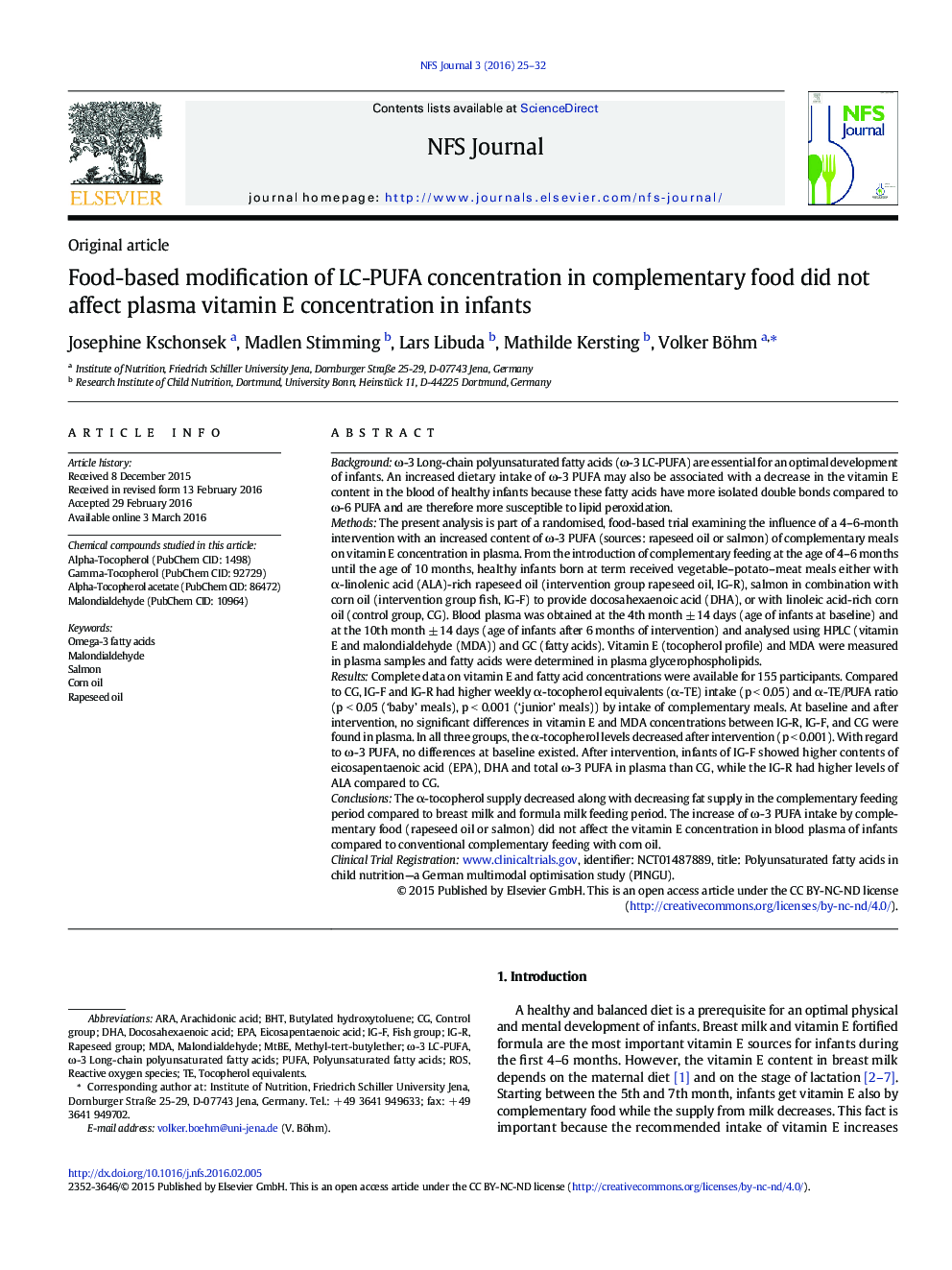| Article ID | Journal | Published Year | Pages | File Type |
|---|---|---|---|---|
| 1085611 | NFS Journal | 2016 | 8 Pages |
•Complementary meals modified fatty acid status but not α-tocopherol status in infants.•Decrease of α-tocopherol in plasma independent of ω-3 PUFA intake•α-Tocopherol supply decreased with decreasing fat supply during complementary feeding.
Backgroundω-3 Long-chain polyunsaturated fatty acids (ω-3 LC-PUFA) are essential for an optimal development of infants. An increased dietary intake of ω-3 PUFA may also be associated with a decrease in the vitamin E content in the blood of healthy infants because these fatty acids have more isolated double bonds compared to ω-6 PUFA and are therefore more susceptible to lipid peroxidation.MethodsThe present analysis is part of a randomised, food-based trial examining the influence of a 4–6-month intervention with an increased content of ω-3 PUFA (sources: rapeseed oil or salmon) of complementary meals on vitamin E concentration in plasma. From the introduction of complementary feeding at the age of 4–6 months until the age of 10 months, healthy infants born at term received vegetable–potato–meat meals either with α-linolenic acid (ALA)-rich rapeseed oil (intervention group rapeseed oil, IG-R), salmon in combination with corn oil (intervention group fish, IG-F) to provide docosahexaenoic acid (DHA), or with linoleic acid-rich corn oil (control group, CG). Blood plasma was obtained at the 4th month ± 14 days (age of infants at baseline) and at the 10th month ± 14 days (age of infants after 6 months of intervention) and analysed using HPLC (vitamin E and malondialdehyde (MDA)) and GC (fatty acids). Vitamin E (tocopherol profile) and MDA were measured in plasma samples and fatty acids were determined in plasma glycerophospholipids.ResultsComplete data on vitamin E and fatty acid concentrations were available for 155 participants. Compared to CG, IG-F and IG-R had higher weekly α-tocopherol equivalents (α-TE) intake (p < 0.05) and α-TE/PUFA ratio (p < 0.05 (‘baby’ meals), p < 0.001 (‘junior’ meals)) by intake of complementary meals. At baseline and after intervention, no significant differences in vitamin E and MDA concentrations between IG-R, IG-F, and CG were found in plasma. In all three groups, the α-tocopherol levels decreased after intervention (p < 0.001). With regard to ω-3 PUFA, no differences at baseline existed. After intervention, infants of IG-F showed higher contents of eicosapentaenoic acid (EPA), DHA and total ω-3 PUFA in plasma than CG, while the IG-R had higher levels of ALA compared to CG.ConclusionsThe α-tocopherol supply decreased along with decreasing fat supply in the complementary feeding period compared to breast milk and formula milk feeding period. The increase of ω-3 PUFA intake by complementary food (rapeseed oil or salmon) did not affect the vitamin E concentration in blood plasma of infants compared to conventional complementary feeding with corn oil.Clinical Trial Registrationwww.clinicaltrials.gov, identifier: NCT01487889, title: Polyunsaturated fatty acids in child nutrition—a German multimodal optimisation study (PINGU).
Graphical abstractFigure optionsDownload full-size imageDownload as PowerPoint slide
